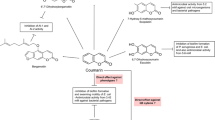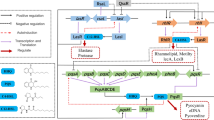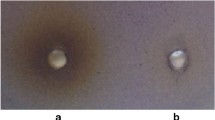Abstract
The continuous increase in the incidence of infectious diseases and the rapid unchecked rise in multidrug-resistance to conventional antibiotics have led to the search for alternative strategies for treatment and clinical management of microbial infections. Since quorum sensing (QS) regulates numerous virulence determinants and pathogenicity in bacteria, inhibition of QS promises to be an attractive target for development of novel therapeutics. In this study, a series of cinnamic acid analogs and benzalacetone analogs were designed and synthesized, and their QS-inhibitory activities explored. We found that, among the test compounds, 4-methoxybenzalacetone (8) exhibited potent anti-quorum sensing property, as evidenced by inhibition of QS-controlled violacein production of Chromobacterium violaceum ATCC12472. The inhibitory activity of such a compound, which was the methyl keto analog of the corresponding cinnamic acid, was not only stronger than the parent cinnamic acid (1), but also superior to that of furanone, the reference drug. Based on our observations, its mechanism of quorum sensing inhibition is likely to be mediated by interference with N-acyl-homoserine lactones (AHL) synthesis. Moreover, 4-methoxybenzalacetone (8) also suppressed the production of pyocyanin, rhamnolipids and swarming motility of Pseudomonas aeruginosa, suggesting a broad spectrum of anti-QS activities of this compound. In terms of structure–activity relationship, the possible chemical substitutions on the scaffold of cinnamic acid required for QS inhibitory activity are also discussed. Since 4-methoxybenzalacetone (8) showed no toxicity to both bacteria and mammalian cells, our findings therefore indicate the anti-QS potential of this compound as a novel effective QS inhibitor.







Similar content being viewed by others
Data availability
Data supporting this study is provided as supplementary material accompanying this paper.
Code availability
Not applicable.
References
Abisado RG, Benomar S, Klaus JR, Dandekar AA, Chandler JR (2018) Bacterial quorum sensing and microbial community interactions. mBio 9:e02331-02317
Adisakwattana S (2017) Cinnamic acid and its derivatives: mechanisms for prevention and management of diabetes and its complications. Nutrients 9(2):163
Ahmed SAKS, Rudden M, Smyth TJ, Dooley JSG, Marchant R, Banat IM (2019) Natural quorum sensing inhibitors effectively downregulate gene expression of Pseudomonas aeruginosa virulence factors. Appl Microbiol Biotechnol 103:3521–3535
Asfour HZ (2018) Anti-quorum sensing natural compounds. J Microsc Ultrastruct 6:1–10
Brackman G, Coenye T (2015) Quorum sensing inhibitors as anti-biofilm agents. Curr Pharm Des 21:5–11
Burt SA, Ojo-Fakunle VT, Woertman J, Veldhuizen EJ (2014) The natural antimicrobial carvacrol inhibits quorum sensing in Chromobacterium violaceum and reduces bacterial biofilm formation at sub-lethal concentrations. PLoS One 9:e93414
Chokshi A, Sifri Z, Cennimo D, Horng H (2019) Global contributors to antibiotic resistance. J Glob Infect Dis 11:36–42
Choo JH, Rukayadi Y, Hwang JK (2006) Inhibition of bacterial quorum sensing by vanilla extract. Lett Appl Microbiol 42:637–641
Chuprajob T, Changtam C, Chokchaisiri R, Chunglok W, Sornkaew N, Suksamrarn A (2014) Synthesis, cytotoxicity against human oral cancer KB cells and structure-activity relationship studies of trienone analogues of curcuminoids. Bioorg Med Chem Lett 24:2839–2844
Defoirdt T (2018) Quorum-sensing systems as targets for antivirulence therapy. Trends Microbiol 26:313–328
Demoss RD, Happel ME (1959) Nutritional requirements of Chromobacterium violaceum. J Bacteriol 77:137–141
Deryabin D, Galadzhieva A, Kosyan D, Duskaev G (2019) Plant-derived inhibitors of AHL-mediated quorum sensing in bacteria: modes of action. Int J Mol Sci 20:5588
Fernández-Martínez E, Bobadilla RA, Morales-Ríos MS, Muriel P, Pérez-Álvarez V (2007) Trans-3-phenyl-2-propenoic acid (cinnamic acid) derivatives: structure-activity relationship as hepatoprotective agents. Med Chem 3:475–479
Fleitas Martínez O, Rigueiras PO, Pires ÁDS, Porto WF, Silva ON, de la Fuente-Nunez C, Franco OL (2019) Interference with quorum-sensing signal biosynthesis as a promising therapeutic strategy against multidrug-resistant pathogens. Front Cell Infect Microbiol 8:444
Haque S, Ahmad F, Dar SA, Jawed A, Mandal RK, Wahid M, Lohani M, Khan S, Singh V, Akhter N (2018) Developments in strategies for quorum sensing virulence factor inhibition to combat bacterial drug resistance. Microb Pathog 121:293–302
Haque S, Yadav DK, Bisht SC, Yadav N, Singh V, Dubey KK, Jawed A, Wahid M, Dar SA (2019) Quorum sensing pathways in Gram-positive and -negative bacteria: potential of their interruption in abating drug resistance. J Chemother 31:161–187
Hirakawa H, Tomita H (2013) Interference of bacterial cell-to-cell communication: a new concept of antimicrobial chemotherapy breaks antibiotic resistance. Front Microbiol 4:114
Imai M, Yokoe H, Tsubuki M, Takahashi N (2019) Growth inhibition of human breast and prostate cancer cells by cinnamic acid derivatives and their mechanism of action. Biol Pharm Bull 42:1134–1139
Karatas O, Balci Yuce H, Taskan MM, Gevrek F, Alkan C, Isiker Kara G, Temiz C (2020) Cinnamic acid decreases periodontal inflammation and alveolar bone loss in experimental periodontitis. J Periodontal Res 55:676–685
Khan F, Manivasagan P, Pham DTN, Oh J, Kim SK, Kim YM (2019) Antibiofilm and antivirulence properties of chitosan-polypyrrole nanocomposites to Pseudomonas aeruginosa. Microb Pathog 128:363–373
Koch AK, Käppeli O, Fiechter A, Reiser J (1991) Hydrocarbon assimilation and biosurfactant production in Pseudomonas aeruginosa mutants. J Bacteriol 173:4212–4219
Krishnan T, Yin WF, Chan KG (2012) Inhibition of quorum sensing-controlled virulence factor production in Pseudomonas aeruginosa PAO1 by Ayurveda spice clove (Syzygium aromaticum) bud extract. Sensors (basel) 12:4016–4030
Lee Z, Zhang L (2015) The hierarchy quorum sensing network in Pseudomonas aeruginosa. Protein Cell 6:26–41
Luo J, Kong JL, Dong BY, Huang H, Wang K, Wu LH, Hou CC, Liang Y, Li B, Chen YQ (2016) Baicalein attenuates the quorum sensing-controlled virulence factors of Pseudomonas aeruginosa and relieves the inflammatory response in P. aeruginosa-infected macrophages by downregulating the MAPK and NFkappaB signal-transduction pathways. Drug Des Devel Ther 10:183–203
Manner S, Fallarero A (2018) Screening of natural product derivatives identifies two structurally related flavonoids as potent quorum sensing inhibitors against gram-negative bacteria. Int J Mol Sci 19:1346
Martinelli D, Grossmann G, Séquin U, Brandl H, Bachofen R (2004) Effects of natural and chemically synthesized furanones on quorum sensing in Chromobacterium violaceum. BMC Microbiol 4:25
McClean KH, Winson MK, Fish L, Taylor A, Chhabra SR, Camara M, Daykin M, Lamb JH, Swift S, Bycroft BW, Stewart GS, Williams P (1997) Quorum sensing and Chromobacterium violaceum: exploitation of violacein production and inhibition for the detection of N-acylhomoserine lactones. Microbiology 143:3703–3711
McLean RJ, Pierson LSI, Fuqua C (2004) A simple screening protocol for the identification of quorum signal antagonists. J Microbiol Methods 58:351–360
Mosmann T (1983) Rapid colorimetric assay for cellular growth and survival: application to proliferation and cytotoxicity assays. J Immunol Methods 65:55–63
Mukherjee S, Bassler BL (2019) Bacterial quorum sensing in complex and dynamically changing environments. Nat Rev Microbiol 17:371–382
Munir S, Shah AA, Shahid M, Manzoor I, Aslam B, Rasool MH, Saeed M, Ayaz S, Khurshid M (2020) Quorum sensing interfering strategies and their implications in the management of biofilm-associated bacterial infections. Braz Arch Biol Technol 63:e20190555
Nadeem SF, Gohar UF, Tahir SF, Mukhtar H, Pornpukdeewattana S, Nukthamna P, Moula Ali AM, Bavisetty SCB, Massa S (2020) Antimicrobial resistance: more than 70 years of war between humans and bacteria. Crit Rev Microbiol 46:578–599
Otero E, Robledo SM, Díaz S, Carda M, Muñoz D, Paños J, Vélez ID, Cardona W (2014) Synthesis and leishmanicidal activity of cinnamic acid esters: structure–activity relationship. Med Chem Res 23:1378–1386
Papenfort K, Bassler BL (2016) Quorum sensing signal-response systems in Gram-negative bacteria. Nat Rev Microbiol 14:576–588
Perkin WH (1877) On some hydrocarbons obtained from the homologues of cinnamic acid; and on anethol and its homologues. J Chem Soc 32:660–674
Piewngam P, Chiou J, Chatterjee P, Otto M (2020) Alternative approaches to treat bacterial infections: targeting quorum-sensing. Expert Rev Anti Infect Ther 18:499–510
Rasmussen TB, Givskov M (2006) Quorum-sensing inhibitors as anti-pathogenic drugs. Int J Med Microbiol 296:149–161
Saeki EK, Kobayashi RKT, Nakazato G (2020) Quorum sensing system: Target to control the spread of bacterial infections. Microb Pathog 142:104068
Singh BN, Singh BR, Singh RL, Prakash D, Sarma BK, Singh HB (2009) Antioxidant and anti-quorum sensing activities of green pod of Acacia nilotica L. Food Chem Toxicol 47:778–786
Sova M (2012) Antioxidant and antimicrobial activities of cinnamic acid derivatives. Mini Rev Med Chem 12:749–767
Tan LY, Yin WF, Chan KG (2013) Piper nigrum, Piper betle and Gnetum gnemon-natural food sources with anti-quorum sensing properties. Sensors (basel) 13:3975–3985
Vandeputte OM, Kiendrebeogo M, Rajaonson S, Diallo B, Mol A, El Jaziri M, Baucher M (2010) Identification of catechin as one of the flavonoids from Combretum albiflorum bark extract that reduces the production of quorum-sensing-controlled virulence factors in Pseudomonas aeruginosa PAO1. Appl Environ Microbiol 76:243–253
Vasconcelos NG, Croda J, Simionatto S (2018) Antibacterial mechanisms of cinnamon and its constituents: A review. Microb Pathog 120:198–203
Wahman S, Emara M, Shawky RM, El-Domany RA, Aboulwafa MM (2015) Inhibition of quorum sensing-mediated biofilm formation in Pseudomonas aeruginosa by a locally isolated Bacillus cereus. J Basic Microbiol 55:1406–1416
Wang H, Chu W, Ye C, Gaeta B, Tao H, Wang M, Qiu Z (2019) Chlorogenic acid attenuates virulence factors and pathogenicity of Pseudomonas aeruginosa by regulating quorum sensing. Appl Microbiol Biotechnol 103:903–915
Zhao X, Yu Z, Ding T (2020) Quorum-sensing regulation of antimicrobial resistance in bacteria. Microorganisms 8:425
Funding
This work was supported by the National Research Council of Thailand through the Annual Research Fund of Naresuan University (Grant Number R2559B069). Supports from The Thailand Research Fund (DBG6180030) and the Center of Excellence for Innovation in Chemistry, Ministry of Higher Education, Science, Research, and Innovation are gratefully acknowledged.
Author information
Authors and Affiliations
Contributions
Conceptualization: DK and AS; Methodology: PJ, WP, AN; Formal analysis and investigation: PJ, WP, AN; Writing—original draft preparation: PJ, DK and AS; Writing—review and editing: DK, WP and AS; Funding acquisition: DK and AS; Supervision: DK and AS.
Corresponding author
Ethics declarations
Conflict of interest
The authors declared that they have no conflict of interest.
Ethical approval
This study does not contain any experiments with human participants or animals performed by any of the authors.
Consent to participate
Not applicable.
Consent for publication
All authors agreed on the publication.
Additional information
Publisher's Note
Springer Nature remains neutral with regard to jurisdictional claims in published maps and institutional affiliations.
Supplementary Information
Below is the link to the electronic supplementary material.
Rights and permissions
About this article
Cite this article
Jantaruk, P., Pabuprapap, W., Nakaew, A. et al. 4-methoxybenzalacetone, the cinnamic acid analog as a potential quorum sensing inhibitor against Chromobacterium violaceum and Pseudomonas aeruginosa. World J Microbiol Biotechnol 37, 153 (2021). https://doi.org/10.1007/s11274-021-03119-x
Received:
Accepted:
Published:
DOI: https://doi.org/10.1007/s11274-021-03119-x




